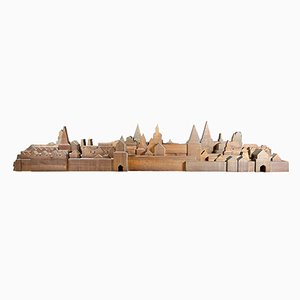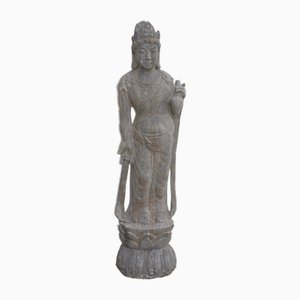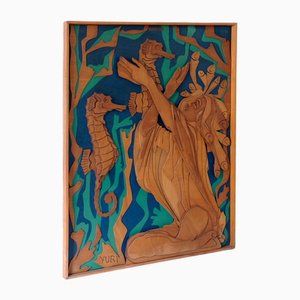Automatisch generierte Übersetzung
Original anzeigen
Übersetzung anzeigen
After Jean de BOLOGNE known as GIAMBOLOGNA (1529-1608), The messenger of the gods, winged ankles, wearing a petascope, holding the caduceus symbolizing trade and eloquence and pointing the purse towards the heavens, here is Mercury, flying, carried by the breath of Zephyr on which he is balanced.
This magnificent realization is in bronze with a black patina, it rests on a cylindrical base decorated with a frieze in bas-relief representing an allegory of the arts after Clodion, magnified by a very nice base in Carrara marble "peach blossom", with a creamy white background, made up of irregular fragments going from peach yellow to violet.
Period : XIXth Century
Circa : 1900
Dimensions : Total height : 45cm
Diameter of the base : 13cm
This aerial bronze, inspired by the ancient stories of the Odyssey and the Aeneid, is a reduction of the life-size model executed by Giambologna in 1580, destined to surmount the fountain in the gardens of the Villa Medici in Rome and kept in the "Museo Nazionale del Bargello", in Florence.
Leone Leoni had made for Maximilian II, a medal representing Mercury flying on the reverse.
The name "Flying Mercury" is attributed to Antonio Vasari.
Giambologna made four versions of the Flying Mercury, of which this one may be after the copy made for the Emperor Maximilian or that of the Medici.
Giambologna or Jean de Boulogne was born in Douai in 1529. He was a pupil of Jacques Dubroeucq and then went to Italy and visited Florence in 1552 where he obtained the protection of the Medici.
Influenced by Michelangelo and the artists of antiquity, he settled in Florence where he was to exert considerable influence in Europe.
He is known and recognized for the realization among others of the famous groups of Samson, the triumph of Pisa, the rap of the Sabines, Hercules and the centaur, Bacchus, Mercury, Neptune and the fabulous equestrian statue of Cosimo I of Medici.
Bibliography: -C. Avery: La sculpture renaissances à Florence, 1970, L'œuvre complète de Giambologna, 1987, Études des sculpteurs européens in 2 volumes, in 1981 and 1987. Jean de Boulogne, Giovanni Bologna Fiammingo, Brussels 1956.
Nach Jean de BOLOGNE, bekannt als GIAMBOLOGNA (1529-1608), Der Bote der Götter, geflügelte Knöchel, trägt ein Petascope, hält den Caduceus, der Handel und Beredsamkeit symbolisiert, und richtet die Geldbörse in den Himmel, hier ist Merkur, fliegend, getragen vom Atem des Zephyrs, auf dem er balanciert.
Diese großartige Realisierung ist in Bronze mit einer schwarzen Patina, es ruht auf einem zylindrischen Sockel mit einem Fries in Flachrelief verziert, die eine Allegorie der Künste nach Clodion, durch eine sehr schöne Basis in Carrara-Marmor "Pfirsichblüte" vergrößert, mit einem cremeweißen Hintergrund, aus unregelmäßigen Fragmenten gehen von Pfirsichgelb bis violett.
Zeitraum: XIX. Jahrhundert
Zeitrechnung : 1900
Abmessungen: Gesamthöhe : 45cm
Durchmesser des Sockels : 13cm
Diese Luftbronze, die von den antiken Geschichten der Odyssee und der Aeneis inspiriert ist, ist eine Verkleinerung des lebensgroßen Modells von Giambologna aus dem Jahr 1580, das für den Brunnen in den Gärten der Villa Medici in Rom bestimmt war und im "Museo Nazionale del Bargello" in Florenz aufbewahrt wird.
Leone Leoni hatte für Maximilian II. eine Medaille angefertigt, die auf der Rückseite den fliegenden Merkur darstellt
Der Name "Fliegender Merkur" wird Antonio Vasari zugeschrieben
Giambologna fertigte vier Versionen des fliegenden Merkur an, von denen diese nach der für Kaiser Maximilian oder die Medici angefertigten Kopie sein könnte
Giambologna oder Jean de Boulogne wurde 1529 in Douai geboren. Er war Schüler von Jacques Dubroeucq und ging dann nach Italien und besuchte 1552 Florenz, wo er den Schutz der Medici erhielt
Beeinflusst von Michelangelo und den Künstlern der Antike, ließ er sich in Florenz nieder, wo er einen großen Einfluss in Europa ausüben sollte
Bekannt und anerkannt ist er unter anderem für die Realisierung der berühmten Samson-Gruppen, des Triumphs von Pisa, der Vergewaltigung der Sabiner, des Herkules und des Kentauren, des Bacchus, des Merkur, des Neptun und des fabelhaften Reiterstandbilds von Cosimo I. von Medici
Bibliographie: -C. Avery: La sculpture renaissances à Florence, 1970, L'œuvre complète de Giambologna, 1987, Études des sculpteurs européens in 2 Bänden, 1981 und 1987. Jean de Boulogne, Giovanni Bologna Fiammingo, Brüssel 1956.




Schreiben Sie uns
Ein Angebot machen
Uns ist aufgefallen, dass Sie neu bei Pamono sind!
Bitte akzeptieren Sie die Allgemeinen Geschäftsbedingungen und die Datenschutzerklärung
Schreiben Sie uns
Ein Angebot machen
Fast geschafft!
Um die Kommunikation einsehen und verfolgen zu können, schließen Sie bitte Ihre Registrierung ab. Um mit Ihrem Angebot auf der Plattform fortzufahren, schließen Sie bitte die Registrierung ab.Erfolgreich
Vielen Dank für Ihre Anfrage! Unser Team meldet sich in Kürze bei Ihnen zurück.
Wenn Sie Architekt*in oder Inneneinrichter*in sind, bewerben Sie sich hier um dem Trage Program beizutreten.